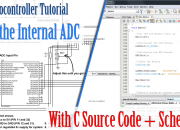
Using the ADC (Analog to Digital Converter) of PIC Microcontroller
Many electrical signals around us are Analog in nature. That means a quantity varies directly with some other quantity. The first quantity is mostly voltage while that second quantity can be anything like temperature, pressure, light, force or acceleration. For example in LM35 temperature sensor the output voltage varies according to the temperature, so if we could measure voltage, we can measure temperature. But most of our computer (or Microcontrollers) are digital in nature. They can only differentiate between HIGH or LOW level on input pins. For example if input is more than 2.5v it will be read as 1 and if it is below 2.5 then it will be read as 0 (in case of 5v systems). So we cannot measure voltage directly from MCUs. To solve this problem most modern MCUs have an ADC unit. ADC stands for analog to digital converter. It will convert a voltage to a number so that it can be processed by a digital systems like MCU. This enables us to easily interface all sort of analog devices with MCUs. Some really helpful example of analog devices are Light Sensors. Temperature Sensors. Accelerometers. Touch Screens. Microphone for Audio Recording. And possibly many more. In this tutorials we will learn to use the internal ADC of PIC18 devices (Example is for PIC18F4520 which is […]
